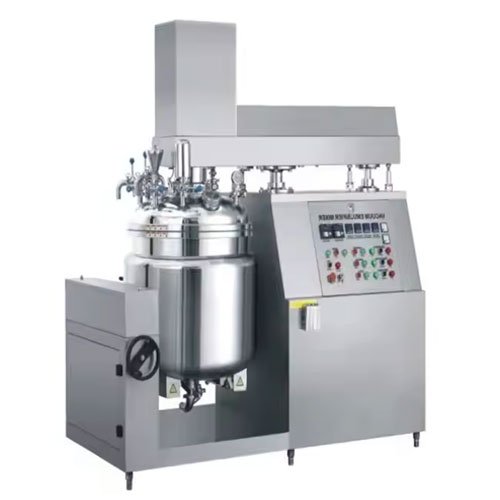A Cream Production Plant is an integrated system designed to manufacture cream-based products in a hygienic, efficient, and controlled manner. These plants are extensively used in industries such as pharmaceuticals, cosmetics, and personal care to produce a wide range of products like:
- Skincare creams (anti-aging, moisturizing, sunscreen)
- Medicinal ointments (antibiotic creams, anti-inflammatory ointments)
- Hair care products (styling creams, conditioners)
- Herbal creams
- Body lotions
The plant ensures uniform mixing, homogenization, and emulsification of active ingredients, excipients, and other additives, resulting in high-quality and stable products.
Features of a Cream Production Plant
Modern cream production plants come equipped with advanced features for seamless operations, such as:
- GMP-compliant design: Ensures hygiene, safety, and regulatory compliance.
- Compact modular construction: Space-saving design that is easy to install.
- Automatic control systems: PLC-based or SCADA-integrated control panels for precise operation.
- High-shear homogenization: Achieves smooth texture and stable emulsions.
- Vacuum system: Prevents air entrapment and bubble formation in the cream.
- CIP (Clean-in-Place) system: Enables automatic cleaning and sterilization of the equipment.
- Energy-efficient heating and cooling systems: Jacketed vessels for temperature control.
- Sanitary-grade components: Use of stainless steel (SS316/SS304) to ensure product safety.
Working Principle of a Cream Production Plant
The cream manufacturing process in a production plant follows these steps:
- Raw Material Addition:
Ingredients such as oils, waxes, water, active substances, and emulsifiers are added to different mixing vessels. - Heating and Melting:
Water and oil phases are heated in separate jacketed vessels to ensure proper melting and preparation. - Mixing and Emulsification:
The heated oil and water phases are transferred to the main mixing vessel, where high-speed homogenizers and agitators blend the ingredients to form a stable emulsion. - Vacuum Mixing:
A vacuum system removes air from the mixture, preventing bubble formation and ensuring a smooth texture. - Cooling:
The emulsion is cooled gradually to achieve the desired viscosity and consistency. - Filtration:
The cream is passed through inline filters to ensure it is free of impurities. - Storage and Transfer:
The prepared cream is stored in holding tanks and transferred to filling machines for packaging.
Equipment and Accessories in a Cream Production Plant
A standard cream production plant comprises the following key equipment and accessories:
- Water Phase Vessel: For heating and mixing water-soluble ingredients.
- Oil Phase Vessel: For heating and mixing oil-based ingredients.
- Vacuum Homogenizer Mixer: The main vessel for emulsification, mixing, and de-aeration.
- Storage Tanks: For holding the prepared cream under sterile conditions.
- Inline Homogenizer: For achieving a finer and more uniform emulsion.
- Transfer Pumps: For transferring product between vessels or to filling lines.
- Heating and Cooling Systems: Jacketed vessels or heat exchangers for temperature regulation.
- Control Panel: PLC-based automation for precise monitoring and operation.
- Piping and Valves: Sanitary-grade components to maintain hygiene.
Optional Features of a Cream Production Plant
To cater to specific production requirements, cream production plants can be customized with additional features, such as:
- Load Cell Weighing System: Ensures accurate dosing of ingredients.
- SCADA Integration: Enables advanced monitoring and data logging of production parameters.
- Automatic pH Control: For maintaining the required pH level of the cream.
- Explosion-proof Design: For manufacturing creams containing volatile or flammable substances.
- Double Filtration System: Ensures ultra-clean products, free of particulate matter.
- Batch Recording System: Tracks and records batch details for regulatory compliance.
- Insulated Vessels: Reduces energy consumption and enhances process efficiency.
Production Capacities of Cream Production Plants
Cream production plants are available in a variety of capacities to suit the needs of small, medium, and large-scale manufacturers. Typical capacities include:
- Small-scale production: 10 liters to 100 liters per batch
- Medium-scale production: 100 liters to 500 liters per batch
- Large-scale production: 500 liters to 5000 liters per batch
The capacity selection depends on factors such as production volume, product variety, and investment capacity.
Benefits of Using a Cream Production Plant
- Enhanced production efficiency and reduced time per batch.
- Consistent product quality with uniform emulsions.
- Compliance with international standards (GMP, FDA, etc.).
- Reduced manual intervention, minimizing human error and contamination risks.
- Cost-effective in terms of energy and resource utilization.
A Cream Production Plant is a vital investment for businesses in the pharmaceutical, cosmetic, and personal care industries. By ensuring high-quality production, minimizing wastage, and adhering to GMP standards, these plants provide a competitive edge in the market. Whether you are manufacturing skincare creams, medicinal ointments, or hair care products, a cream production plant is designed to meet diverse requirements with precision and efficiency.
Choose a reliable manufacturer to customize the plant as per your needs and scale your production capabilities while maintaining the highest product standards.









